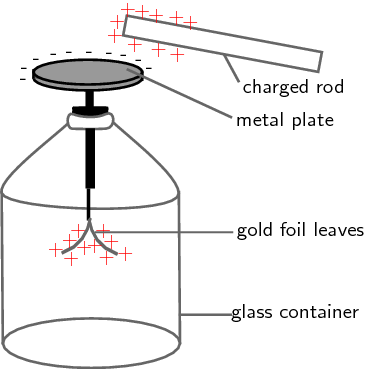Day 22
Context
With our background of matter and atoms we are now able to start talking about interactions.
Explanation
| Video Links |
Video Popup
|
Class Video
|
We will start with charge interactions.
After this class you should be able to:
- List the fundamental charges.
- List the three interactions between like and unlike charges.
- Explain how temporary dipoles are created when a charged object interacts with a neutral object.
Fundamental Charges and Interactions
How many charges are there?
- What is the fundamental positive charge?
- What is the fundamental negative charge?
- Is there a neutral charge?
- How does a positive charge interact with another positive charge?
- How does a positive charge interact With a negative charge?
- How do two negative charges interact?
- What is the general statement that is often quoted?
Three Premises
Pith balls are taken from the inside of a plant. They are very light and easily moved. Hang a pith ball from a string and a very slight blow will make it move.
What will happen when a negatively charged rod is placed next to a neutral pith ball?
Here is a video of a charged cloth interacting with a neutral pith ball.Draw a picture at the "molecular" level, showing the plus and minus charges in the pith ball before and after the rod it put close to it.
Recall that the electrons are very small compared to the nucleus and that means that if anything is going to move in an atom it will be the electrons. Using that and our charge interactions we can agree on the following three premises.
- If anything moves it will be the electrons.
- Like charges repel.
- Unlike charges attract.
Does the picture you gave for the negative rod next to the pith ball agree with all three premises?
Electroscopes
Some people call a pith ball hanging from a string an electroscope, but usually an electroscope is a little more than that. Here is a picture I found on the internet that I would call an electroscope.

How does this work at the "molecular" level? What would happen if the rod was negative? Explain. What would happen if the rod touches the metal plate of the electroscope?
Temporary Dipoles
Placing a charged rod next to a neutral pith ball causes the electrons to shift within the pith ball. When the electrons shift in the pith ball it creates one end of the pith ball that is a little negative and one end that is a little positive. When you have a separation of charge like that it is called a dipole. These are temporary dipoles because when you take away the charged rod, the electrons go back and there is no longer a dipole.
I have prepared a page with answers to the above questions which will be available after our discussion in class. If you can't get to it after class remind me to activate it!
Making Charges - A Reminder
Remember that in order to make a charge you have to transfer electrons. When we make these temporary dipoles there are no electrons transfered. The electrons shift inside of the pith ball, but they are not transferred. Something with a temporary dipole doesn't have a charge. They do have one end that is a little bit positive and another end that is a little bit negative, but they are both the same magnitude and cancel each other out so that there is no overall charge.
Homework
One of the last questions of your next class review homework will be about a ring floating above a rod. This is done by charging a styrofoam ring and a rod with the same material and then picking up the ring with the insulated end of the rod and placing it above the rod where it floats. You are to write an argument that explains how the ring floats above the rod. I used to do this in class, but here is a video of what I am talking about.
The homework associated with Day 22 is a the Class Review Homework Set #3.